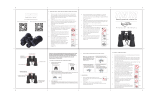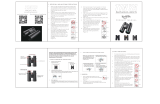
www.celest ron.com
BINOCULARS
Thank you for purchasing Celestron binoculars and we hope you will have
many years of pleasure with them. To maximize your enjoyment of the bin-
oculars, please read these instructions on use and care before using them.
1. Adjusting the Interpupillary Distance (IPD) Since the distance
between the eyes (specifically, the distance between the centers of the
pupils) varies among individuals, the two eyepieces of the binoculars must
be correctly aligned (adjusted). This is called adjusting the interpupillary
distance. To adjust this distance, lift the binoculars up to your eyes (using
both hands) and look through them at an object in the distance. Move the
two halves of the binoculars about the hinge until you see one clear circle
of image through both eyes.
2. Adjusting Focus Since most people have a variance of vision from
their left eye to their right eye, you must adjust the focusing system. Use
the following steps to achieve focus: (1) Close your right eye and look
through the left side of the binoculars with your left eye at the subject
matter. Rotate the center focusing wheel until the image appears in sharp
focus; (2) Close your left eye and look through the right eyepiece (called
the diopter). Rotate the right eyepiece until the image appears in sharp
focus; (3) Now look through both eyepieces with both eyes open. Since
you’ve already adjusted the right eyepiece, use only the center focusing
wheel to refocus on a new object at a different distance.
IPD Scale
IPD
Porro Binocular
Roof Binocular
Note: If your binocular has a diopter indicator, please note the setting for
later use for faster focus adjustment.
For Zoom Binocular models – to increase or decrease power, move the
zoom lever. To adjust focus you first zoom the binoculars to the highest
power and then adjust the focusing system as above. Then, when zooming
in and out your binoculars will be in focus.
Hint: Eyeglasses worn for nearsightedness should be worn when using
binoculars as you may not be able to reach a sharp focus at infinity
without them.
3. Set the Rubber Eyecups Leave the Rubber Eyecups up if you do not
wear eyeglasses but fold them down if you do wear eyeglasses to obtain
the maximum field of view. When done observing, fold the eyecups up
for storage.
4. Tripod Adaptability Porro Prism binoculars feature a built-in tripod
adapter fitting. On these models, a threaded screw hole is underneath a
cap. To attach a binocular tripod adapter, remove the cap and then thread
the screw from the binocular tripod adapter into the threaded screw hole.
The other end of the binocular tripod adapter attaches to a photographic
tripod. Mounting binoculars this way allows for added stability and comfort
especially when viewing at high powers.
ROOF PRISM BINOCULAR
Diopter
Adjustment
Objective Lens
Eyepiece
Focuser
Rubber Eyecup
PORRO PRISM BINOCULAR
Diopter
Adjustment
Objective
Lens
Tripod
Adapter
Thread
Zoom Lever
(for Zoom Models)
Eyepiece
Focuser
Rubber
Eyecup
5. Care and Cleaning Binoculars do not need routine maintenance other
than making sure that the objective lenses and eyepieces are kept clean.
If repairs become necessary, they should be serviced by the manufacturer
or a qualified binocular repair company. Collimation (optical alignment)
is the biggest concern with binoculars. If your binoculars are roughly
handled or dropped, there is a good chance that the collimation will be
out and they should be serviced. Dirty objectives and/or eyepieces mean
less light transmission and loss of brightness as well as unsharp images.
Keep your optics clean ! When not using your binoculars store them in
the case provided. Avoid touching the glass surfaces but if fingerprints
(which contain mild acid) get on them, they should be cleaned as soon as
possible to avoid damaging the coatings. To clean the optical surfaces, we
recommend a lens/optics cleaning kit available at most photo or optical
shops and follow the instructions provided closely. If you have a lot of dust
or dirt accumulated, brush it off gently with a camel’s hair brush and/or
utilize a can of pressurized air before using the cleaning kit. Alternately,
you could use the Celestron LensPen (# 93575) made especially for
cleaning binoculars. Never attempt to clean your binoculars internally or
try to take them apart!
6. Caution! Viewing the sun may cause permanent eye damage.
Do not view the sun with your binoculars or with the naked eye.
7. Problems or Repair If warranty problems arise or repairs are neces-
sary, contact the Celestron technical support department if you live in
the U.S.A. or Canada. If you live elsewhere, please contact the Celestron



